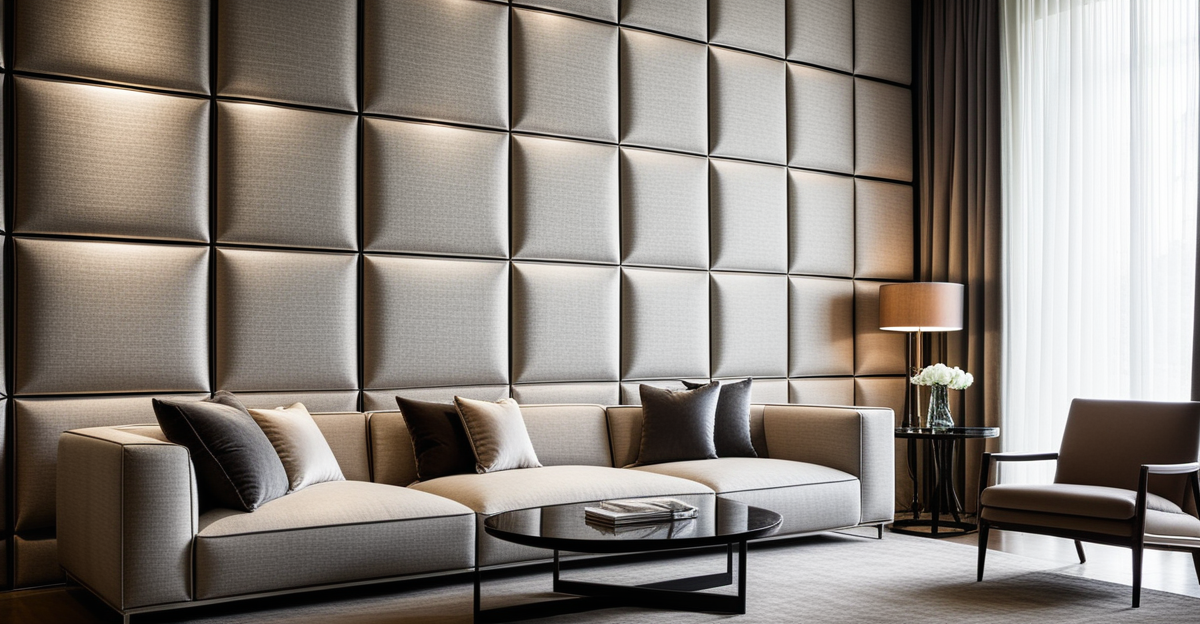Transform your space with stylish upholstered wall panels

Upholstered wall panels combine style and function, adding a plush look while improving room acoustics. Their easy installation and customizable designs let you tailor your space effortlessly. Beyond aesthetics, these panels create a quieter, more comfortable environment, proving both practical and decorative—ideal for anyone seeking a fresh way to enhance interior comfort and visual appeal.
Essential functions and advantages of upholstered wall panels
Delivering a blend of utility and style, upholstered wall panels serve several core roles in both residential and commercial design. These panels are crafted by attaching layers of padding and fabric to a sturdy frame, resulting in decorative padded panels that upgrade spaces visually and functionally. Their popularity is driven by their ability to soften acoustics, infuse warmth, and transform feature walls into eye-catching design elements.
Also to see : How to Build a Small-Scale Aquaponics System for a Year-Round Indoor Vegetable and Fish Harvest?
The primary benefits encompass more than mere aesthetics. They add a plush, tactile surface that boosts comfort and invites relaxation—ideal for bedrooms, headboard walls, and cozy reading nooks. From an acoustic perspective, the panels act as effective soundproof wall coverings. This means less noise transfer, making them excellent for home theaters, offices, or anywhere peace and quiet are desired.
Panel insulation properties help maintain a comfortable indoor climate, reducing unwanted drafts and contributing to energy savings. Furthermore, their soft but resilient surfaces offer wall protection with soft panels; this feature is valuable in high-traffic settings or children’s rooms, minimizing bumps and scuffs. You can view more details on this page: upholstered wall panels.
Also to discover : What’s the Best Way to Design a Cozy, Eco-Friendly Reading Nook Using Recycled Materials?
Design and Material Options for Upholstered Wall Panels
Fabric, Padding, and Cover Choices: Variety and Customisation
Upholstered wall panels are defined by their flexibility in wall panel design styles and upholstery fabrics for walls. Custom wall upholstery allows for extensive experimentation with fabric wall panels—ranging from velvet and suede to leather or linen. The core typically consists of layers of foam, batting, or felt, tailored to desired wall panel textures and materials that can influence the degree of sound absorption and tactile comfort. Durable, washable, and even fire-retardant fabrics expand the selection for modern fabric wall designs, making these padded wall panel shapes a fit for high-traffic and moisture-prone spaces.
Popular Styles: Tufted Panels, Flat Panels, Modern and Classic Treatments
Tufted wall panels remain a favourite, offering a plush, dimensional look with button or stitch detailing. Flat panels provide sleek and understated modern fabric wall designs, perfect for minimalist or contemporary settings. Custom wall upholstery extends from classic to bold, geometric wall panel patterns and shapes—enabling a unique blend with the room’s palette, furniture, and light.
Color, Pattern, and Shape Considerations for Different Interior Aesthetics
Choosing wall panel color trends impacts mood and perception in a space, while wall panel design styles—like diamond, rectangular, or wave—help shape a room’s identity. Upholstery fabrics for walls available in trending hues or distinctive wall panel textures and materials further invite customisation, addressing both decorative intent and practical needs such as insulation or acoustic performance.
Installation methods, DIY options, and maintenance
DIY and professional installation: adhesive, bracket, and panel systems
Upholstered panel installation offers flexibility for both homeowners and professionals. Adhesive methods use wall panel adhesive options for a seamless, tool-free process. Bracket systems allow easy adjustment of removable wall panels, ideal for renters or evolving layouts. Certain DIY fabric wall panels now use clip or panel framework systems, ensuring reliable support and straightforward disassembly for cleaning or redesigns.
Step-by-step guide to installing upholstered wall panels
Begin your wall panel project planning by measuring the installation area. Mark panel positions using a level and pencil. For most easy-to-install wall coverings, apply adhesive directly to the fabric panel’s backing, then press in place. With bracket-mounted panels, securely fasten brackets to the wall before attaching each unit. DIY wall panel tutorials recommend spacing panels consistently for a polished finish. Removable wall panels should be gently clicked or lifted onto their supports.
Essential tips for cleaning, maintenance, and panel longevity
Wall panel maintenance tips include regular vacuuming with a brush attachment and prompt spot-cleaning for stains using recommended fabric panel cleaning methods. Inspect removable wall panels periodically for shifting or residue build-up. Wall panel repair tips: reapply adhesive if corners loosen; for fabric snags, use small upholstery needles. Consistent care preserves your upholstered panel installation’s comfort, style, and sound-reducing qualities.
Costs, Purchasing Advice, and Inspiration
Price Factors: Material Quality, Size, Customisation, and Brand
Precision: The wall panel price range can vary from under £10 per panel to over £100 per square metre, depending on the combination of material, panel size, and degree of customisation. Material quality for affordable wall panels often means lighter foams or budget-friendly fabrics, while luxury soft wall finishes rely on high-grade textiles like velvet, suede, or leather, raising costs. Opting for custom wall panel orders tends to increase the wall panel project cost estimate, but ensures a tailored fit, especially for unique spaces such as bedrooms or home theaters.
Where to Buy: Retailers, Suppliers, and Ordering Custom Panels
Wall panels for bedrooms and living rooms are now widely available through online retailers and local suppliers. For affordable wall panels, large DIY stores offer pre-made solutions with easy-to-install designs, perfect for rental homes or temporary updates. By contrast, reputable brands and upholsterers can fulfil bespoke requests with custom wall panel orders, delivering luxury soft wall finishes and specialised decor with accurate wall panel project cost estimates.
Inspiration: Creative Ideas for Rooms and 2024 Trends
Current wall decor with padded panels showcases bold colour blocking, modern tufting, and eco-friendly finishes. Popular wall panels for home theaters focus on effective acoustic control and plush aesthetics, while wall covering ideas for bedrooms balance calming tones with durable, soft effects. Wall panel trends 2024 include geometric layouts, natural materials, and practical sound insulation—even in spaces like rental homes.
